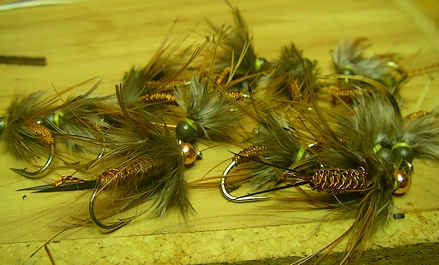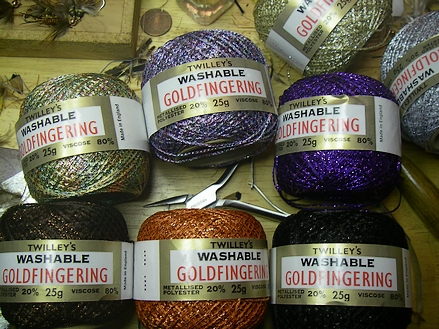One of the reason you buy copper wire by the pound versus the shop spool is so you can dominate the Spring runoff with forty-leven pounds of non-toxic, gutslammer nymphs.
Dynamite is neither green nor legal, and on occasion something just as sinister is warranted.

It doesn’t look like much but that’s three feet of 34 gauge wire per fly, 20 turns of 1 amp fuse wire and a 4mm bead chaser – just what’s needed when the runoff will be short and violent, just like it was last year.
Actually I’m polishing my braiding skills, I used to be able to bang these out really fast – but declining eyesight has slowed me somewhat.
I bought the “Goldfingering” for Shad flies, which should start sometime in the next couple months, it’s a heavy nylon floss wrapped with a complimentary color of mylar. No sooner did I spy it in my “weird stuff to try” bag – when I started braiding more goodies than I’d anticipated.

The dark brown and orange made a handsome combination. The balance of colors (especially the multicolored flavors) will flavor my shad flies for the season. This is really tough material, the mylar shine is partially muted by the floss, so it’ll lend itself to a variety of questionable inspirations.

The bottom view of an “Over and Under” variant. Woven Goldfingering body (dark brown and orange) two turns of Gedifra Costa Rica polyamide hackle. Dub a little fur in front, then grab the hackle on the top and bottom and pull forward to make two wingcases – leaving the fibers on the side for legs.
Outside of the tail and a dab of dubbing it’s another all yarn fly; cheap, expendable, and when your orthodontist pal asks for some you can tell him, “Doctor, No” or equally bad movie quip.

I need to bone up on my braiding skills. impressive ties, once again.
Why do I have images of little kids following Singlebarbed down the shores of the Little Stinking, waiting for him to hang a fly so they can recycle it for the $8.25 it would bring in scrap value…
I’m currently reading John McPhee’s “The Founding Fish,” wherein he describes fly fishing for shad (his favorite fish) in Nova Scotia. Apparently, going after shad with flies is wildly unpopular. How’d you get into it? And how do you find the shad fishing in your neck of the woods?
Those look great! Should really hug the bottom in fast water.
MHH – American Shad are the Tarpon of Freshwater, paper thin mouths and the heart of a lion.
They spawn in Spring, and are usually only available for a couple months. I think the east coast has the Hickory Shad – and has the same popularity as our west coast flavor.
Shad are plankton eaters and respond to any brightly colored fly swung deep – although every year one color emerges as the go-to favorite. THe last couple of years it’s been Pink.
I’ve got a number of posts on my search for them last year – just enter “shad” in the search box above, it’ll show the fish and patterns I’ve used.
If you got the chance, Shad will make you a convert – a fight to the death, and then you let them go. They’re quite oily and bony – so some will smoke them – but mostly it’s their roe that is kept.
Me, I toss them all back, can’t say as I care for fish eggs of any sort.
KB: Indeed. McPhee raves about them as a sport fish in his book (which I highly recommend, along with all his others).
He opens the book with a description of a fight with a 4-lb shad on the Delaware River that lasted two and a half hours. One look at that forked tail they’ve got and you know shad are pretty good athletes, but two and a half hours to land a fish of that size…amazing.
McPhee quite likes the taste of shad as well, and includes a number of suggested preparations for shad and shad roe.
The females are quite large and can get to nearly 7 lbs, males are smaller – often 14″ -15″ inches, shaped like a sunflower seed.
A typical male can peel line off an 8 weight rig, and all of us can be thankful they don’t have teeth … or a taste for human appendages.
You know I be luvin yo flies!
Where do you purchased your 34 gauge wire?
The last batch was from Action Electronics. 36 gauge is listed on the drop down menu, 34 and 32 are also useful. 36 Gauge is roughly our “normal” fly tying wire size.
See the post: http://singlebarbed.com/2007/10/10/i-wouldnt-mind-so-much-if-they-only-doubled-their-money-but-they-prefer-the-consumer-pay-much-more/
I should mention that electronics shops don’t care what color they send you, so you may want to call and specify the color – otherwise you get whatever they have.